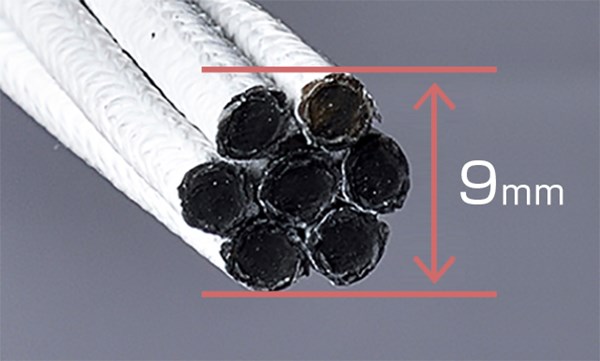Carbon fiber performs aesthetically and structurally
From the informative website called Composites and Architecture, hosted by Kreysler and Associates (American Canyon, CA, US), comes a unique use of carbon fiber strands.

Komatsu Seiren's building in Japan with carbon fiber strands as seismic reinforcement.
For readers who don’t know, there’s a highly interesting and informative website called Composites and Architecture, hosted by Kreysler and Associates (American Canyon, CA, US). If you don’t know Kreysler and Associates, you should — they are a leader in getting composite materials into construction and architectural applications, and we’ve written about their projects on many occasions (here’s two articles: http://www.compositesworld.com/articles/sfmoma-faade-advancing-the-art-of-high-rise-frp; http://www.compositesworld.com/articles/residential-construction-breakthrough-composites-find-a-home).
The aforementioned web site is an eclectic assortment of composites’ use in exteriors, interiors, furniture, sculpture, and new material technology. A recent post involves Japanese textile manufacturer Komatsu Seiren (Ishikawa, Japan), a maker of a variety of fabrics, including some advanced materials. They recently undertook the renovation of their former head office building, with the goal of creating exhibition, museum, office and laboratory spaces, including a rooftop terrace. Project architect Kengo Kuma, interviewed in a video on the Komatsu Seiren web site, wanted to show both the high strength and the lightness and delicacy of carbon fiber strands, using Komatsu Seiren’s own Cabkoma strand rod, developed and manufactured at the facility starting in 2010.
Cabkoma comprises carbon fiber tow that is encapsulated by a sheath of glass or aramid fiber, wet out with a thermoplastic matrix. Seven coated tows are bundled and twisted together to form a single flexible rod, white in color. The company claims the tensile strength of a 5.83mm diameter rod is 38.22 kN (8,592 lbs), or 1.43 kN/mm2 (207,350 psi). The rods are considerably smaller in diameter, and lighter in weight, than steel reinforcement of equal strength; a 160-meter coil of the rod weighs just 12 kg (26.5 lbs). For the rehab and seismic project, the rods were inserted and adhesively bonded into end fittings called rod bearing jigs for attachment to a rooftop anchor structure and into the ground, around the exterior perimeter of the building. They were also used to bolster seismic resistance within the interior, notably, forming lattice shear walls between building columns, with rods oriented at 45° angles.

Closeup of the Cabkoma rod product, from the Komatsu Seiren web site.
In effect, the building's exterior has been “wrapped” by hundreds of spaced Cabkoma rods or strands, that almost resemble a sheer undulating fabric. The result is an airy, organic façade that has a fabric-like aesthetic (true to the building’s purpose) while still offering the strength to resist ground motion during an earthquake event.
Kuma says in the video that the project was a challenge, solvable only with today’s computers, to determine how many rods were necessary and how to best accomplish the seismic reinforcement needed (in addition to conventional earthquake reinforcement installed in the building as required by Japanese building code). He believes the rod will “change things” and has the potential to create a major revolution in the world of construction.
Watch the video interview with Kengo Kuma about the building reinforced with Cabkoma strands. Kuma is a well-known Japanese architect and professor at the Graduate School of Architecture at the University of Tokyo: http://www.komatsuseiren.co.jp/cabkoma/en/index.html.
Related Content
Carbon fiber, bionic design achieve peak performance in race-ready production vehicle
Porsche worked with Action Composites to design and manufacture an innovative carbon fiber safety cage option to lightweight one of its series race vehicles, built in a one-shot compression molding process.
Read MoreDevelopment of a composite liquid hydrogen tank for commercial aircraft
Netherlands consortium advances cryogenic composites testing, tank designs and manufacturing including AFP, hybrid winding, welding of tank components and integrated SHM and H2 sensors for demonstrators in 2025.
Read MoreCombining multifunctional thermoplastic composites, additive manufacturing for next-gen airframe structures
The DOMMINIO project combines AFP with 3D printed gyroid cores, embedded SHM sensors and smart materials for induction-driven disassembly of parts at end of life.
Read MoreWelding is not bonding
Discussion of the issues in our understanding of thermoplastic composite welded structures and certification of the latest materials and welding technologies for future airframes.
Read MoreRead Next
Ultrasonic welding for in-space manufacturing of CFRTP
Agile Ultrasonics and NASA trial robotic-compatible carbon fiber-reinforced thermoplastic ultrasonic welding technology for space structures.
Read MoreCutting 100 pounds, certification time for the X-59 nose cone
Swift Engineering used HyperX software to remove 100 pounds from 38-foot graphite/epoxy cored nose cone for X-59 supersonic aircraft.
Read MoreCeramic matrix composites: Faster, cheaper, higher temperature
New players proliferate, increasing CMC materials and manufacturing capacity, novel processes and automation to meet demand for higher part volumes and performance.
Read More












